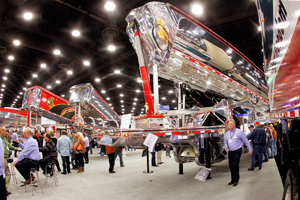Trucking Gathers at MATS

This story appears in the March 31 print edition of Transport Topics.
More than 75,000 people were expected at the 43rd annual Mid-America Trucking Show to get a firsthand look at the latest tractor models, aftermarket accessories and just about everything in between.
The 1.2 million square feet of exhibit space at the Kentucky Exposition Center in Louisville, Ky., is where the majority of the visitors observe the featured attractions in what is known as the largest annual heavy-duty trucking event in the world.
Participants in the March 27-29 event include fleet executives and professional drivers who formally launched the industry’s new image campaign, the top U.S. truck safety regulator, and the head of the world’s largest truck maker.
“We have been sold out for almost a month now. Demand for exhibit space has been up this year,” said Toby Young, president of Exhibit Management Associates, which runs MATS.
He told Transport Topics in a March 21 interview that 1,075 companies were exhibiting “and there are lots and lots of exciting new products and experiences.”
On March 26, executives, including Kevin Burch of Jet Express Inc., convened to formally kickoff of the “Trucking Moves America Forward” image campaign.
Burch, president of the Dayton, Ohio-based carrier, is a vice chairman of American Trucking Associations and a past chairman of the Truckload Carriers Association. He was joined by other industry executives, drivers and technicians to outline the image movement initially announced last fall.
Transport Topics went to press before details of the campaign were disclosed.
A larger public kickoff event was planned for March 28 at Lot J, near the location of the annual Truck Beauty Contest.
The Federal Motor Carrier Safety Administration scheduled a listening session for that same day to gather information regarding knowledge-testing requirements for new entrants to the transportation industry.
FMCSA said it has started working on implementing a written proficiency exam for new applicants, which was mandated as part of 2012’s MAP-21 highway funding law.
Administrator Anne Ferro is expected to participate in the listening session.
A similar listening session on new entrants was conducted in January, and a third is scheduled for early April during the Commercial Vehicle Safety Alliance’s workshop in Los Angeles. All of the listening sessions are webcast, FMCSA said.
The agency also was conducting seminars throughout MATS on commercial vehicle inspections and providing regulatory updates.
On the heels of the agency’s release of its proposal that all interstate truckers use electronic logging devices, Rand McNally hosted a seminar to provide its insight. Additional companies offered similar sessions on the natural-gas market and sleep apnea.
Separately on March 28, Wolfgang Bernhard, head of Daimler AG’s global truck operations, was the scheduled keynote speaker at the Heavy Duty Manufacturers Association’s breakfast. HDMA said he was expected to discuss Daimler’s direction for future growth in world and regional markets.
Bernhard took over the truck unit one year ago. He previously ran Daimler’s Mercedes-Benz passenger car division.
Back in the exhibit hall, Daimler’s Freightliner Trucks, the largest U.S. truck maker, spread the message “commitment to integrated solutions.”
A Freightliner Cascadia natural gas-powered tractor with a 48-inch sleeper was also on display .
Volvo Trucks and Mack Trucks, both part of the Volvo Group, had many of their trucks on display. Volvo Trucks also was touting the efficiency of its smaller engines.
Paccar Inc. and Navistar Inc. each had a large presence at in the exhibit hall, as did engine maker Cummins Inc. and many of the nation’s largest trailer makers.
A wide range of equipment and technology suppliers to the trucking industry were unveiling new products and upgrades, all aimed at making everyone from the large fleet to owner-operator run more efficiently and with lower operating costs.

